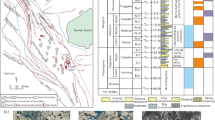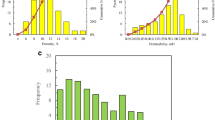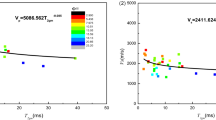Abstract
Tight gas sandstone reservoirs parameters, such as porosity, permeability and initial water saturation, are difficult to be precisely estimated from conventional logs. What’s more, the effective gas-bearing formations cannot be directly identified either due to the characteristics of complicated pore structure, strong heterogeneity and high irreducible water saturation. Nuclear magnetic resonance (NMR) logs, which are usually used to evaluate reservoir pore structure, are found to be effective in evaluating tight gas sandstone reservoirs. In this study, typical tight gas sandstone reservoirs of southwest China are used as examples; techniques of estimating porosity, permeability, initial water saturation and constructing pseudo-capillary pressure curve to quantitative evaluate tight sandstone reservoirs pore structure are studied. The acoustic and NMR logs are combined to calculate porosity. The technique proposed by Volokitin et al. (1999) is used to construct pseudo-capillary pressure curves from NMR logs. The saturation-height-function method is used to estimate initial water saturation, and the Swanson parameter based model is established to calculate permeability from constructed pseudo-capillary pressure curves. Comparisons of estimating porosity, permeability and water saturation with core-derived results illustrate that these techniques are effective in tight gas sands evaluation. Finally, the effective tight gas sands can be identified through combined use of the estimated reservoir parameters and constructed pseudo-capillary pressure curves from NMR logs, which is verified by the drill stem test data.
Similar content being viewed by others
References
Zou C.N.; Zhu R.K.; Liu K.Y.; Su L.; Bai B.; Zhang X.X.; Yuan X.J.; Wang J.H.: Tight gas sandstone reservoirs in China: characteristics and recognition criteria. J. Pet. Sci. Eng. 88(89), 82–91 (2012)
Xiao L.; Mao Z.Q.; Wang Z.N.; Jin Y.: Application of NMR logs in tight gas reservoirs for formation evaluation: a case study of Sichuan basin in China. J. Pet. Sci. Eng. 81, 182–195 (2012)
Coates G.R.; Xiao L.Z.; Primmer M.G.: NMR Logging Principles and Applications, pp. 1–256. Gulf Publishing Company, Houston (2000)
Dunn, K.J.; Bergman, D.J.; Latorraca, G.A.: Nuclear Magnetic Resonance: Petrophysical and Logging Applications. Handbook of Geophysical Exploration. Pergamon, New York, pp. 1–176 (2002)
Xiao L.; Mao Z.Q.; Li G.R.; Jin Y.: Calculation of porosity from nuclear magnetic resonance and conventional logs in gas-bearing reservoirs. Acta Geophys. 60(4), 1030–1042 (2012)
Mao Z.Q.; Xiao L.; Wang Z.N.; Jin Y.; Liu X.G.; Xie B.: Estimation of permeability by integrating nuclear magnetic resonance (NMR) logs with mercury injection capillary pressure (MICP) data in tight gas sands. Appl. Magn. Reson. 44(4), 449–468 (2013)
Xiao, L.: Characterization and Evaluation of Diagenetic Facies and Pore Structure from Well Logs in Low Permeability Sandstones. Dissertation submitted to China University of Petroleum, Beijing, pp. 1–137 (2012)
Xiao L.; Liu X.P.; Mao Z.Q.: A computation method for reservoir permeability by combining NMR log and capillary pressure data. Acta Pet. Sin. 30(1), 100–103 (2009)
Jennings J.W.J.; Lucia F.J.: Predicting permeability from well logs in carbonates with a link to geology for interwell permeability mapping. SPE Reserv. Eval. Eng. 6(4), 215–225 (2003)
Bust V.K.; Oletu J.U.; Worthington P.F.: The challenges for carbonate petrophysics in petroleum resource estimation. SPE Reserv. Eval. Eng. 14(1), 25–34 (2011)
Wei X.L.; Li J.; Xu R.; Zhi L.L.: Establishment of models for tight sandstone formation evaluation in the Ordos Basin of Northwest China. Adv. Mater. Res. 989–994, 1372–1375 (2014)
Archie G.E.: The electrical resistivity log as an aid in determining some reservoir characteristics. TAME 146, 54–61 (1942)
Schlumberger Well Services: Log interpretation charts. Schlumberger Well Services, pp. 1–112 (1986)
Xiao L.; Zou C.C, Mao Z.Q.; Shi Y.J.; Liu X.P.; Jin Y.; Guo H.P.; Hu X.X.: Estimation of water saturation from nuclear magnetic resonance (NMR) and conventional logs in low permeability sandstone reservoirs. J. Pet. Sci. Eng. 108, 40–51 (2013)
Chu Z.H.; Gao J.; Huang L.J.; Xiao L.Z.: Principles and Methods of Geophysical Logging (Part II), pp. 224–326. Petroleum Industry Pressure, Beijing (2007)
Wyllie M.R.J.; Gregory A.R.; Gardner L.W.: Elastic wave velocities in heterogeneous and porous media. Geophysics 21(1), 41–70 (1956)
Guo B.Y.; Ghalambor A.; Duan S.K.: Correlation between sandstone permeability and capillary pressure curves. J. Pet. Sci. Eng. 43(2), 239–246 (2004)
Swanson B.F.: A simple correlation between permeabilities and mercury capillary pressure. J. Pet. Technol. 6(2), 2498–2503 (1981)
Xiao L.; Liu X.P.; Zou C.C.; Hu X.X.; Mao Z.Q.; Shi Y.J.; Guo H.P.; Li G.R.: Comparative study of models for predicting permeability from nuclear magnetic resonance (NMR) logs in two Chinese tight sandstone reservoirs. Acta Geophys. 62(1), 116–141 (2014)
Volokitin, Y.; Looyestijn, W.J.; Slijkerman, W.F.J.; Hofman, J.P.; (1999) A practical approach to obtain 1st drainage capillary pressure curves from NMR core and log data. Paper SCA-9924 presented at the SCA annual symposium
Volokitin Y.; Looyestijn W.J.: A practical approach to obtain primary drainage capillary pressure curves from NMR core and log data. Petrophysics 42(4), 334–343 (2001)
Looyestijn, W.J.: Distinguishing fluid propertyes and producibility from NMR logs. In: Proceedings of the 6th Nordic Symposium on Petrophysics, pp. 1–9 (2001)
Shao W.Z.; Ding Y.J.; Liu Y, Liu S.Q.; Li Y.Q.; Zhao J.H.: The application of NMR log data in evaluation of reservoir pore structure. Well Logging Technol. 33(1), 52–56 (2009)
Purcell W.R.: Capillary pressures-their measurement using mercury and the calculation of permeability thereform. Trans. AIME 186(3), 39–48 (1949)
Kuang, L.C.; Mao, Z.Q.; Sun, Z.C.; Xiao, L.; Luo, X.P. A Method of Consecutively Quantitatively Evaluate Reservoir Pore Structure by Using NMR Log Data. China National Invention Patent: (2010)
Gao, B.; Wu, J.H.; Chen, S.H.; Kwak, H.; Funk, J. (2011) New Method for Predicting Capillary Pressure Curves from NMR Data in Carbonate Rocks. Paper HH presented at the 52nd SPWLA annual logging symposium
Li, G.X.; Wang, Y.H.; Yang, F.P.; Zhao, J. (2006) Computing Gas in Place in a Complex Volcanic Reservoir in China. SPE103790
Li G.X.; Wang Y.H.; Zhao J.; Yang F.P.: Petrophysical characterization of a complex volcanic reservoir, YingCheng Group, Daqing, China. Perophysics 49(2), 113–129 (2008)
Yang, X.W., Zhang, D.W.: Saturation Calculation in Volcanic Reservoirs—A Case Study for Haer Jin in PetroChina Jilin Oilfield. SPE130759 (2010)
Timur, A.: An investigation of permeability, porosity, and residual water saturation relationships. Paper J presented at the 9th SPWLA annual logging symposium (1968)
Kenyon W.E.; Day P.I.; Straley C.: A three-part study of NMR longitudinal relaxation properties of water-saturated sandstones. SPE Form. Eval. 3(3), 622–636 (1988)
Kenyon W.E.: Petrophysical principles of applications of NMR logging. Log Anal. 38(3), 21–43 (1997)
Xiao L.; Mao Z.Q.; Jin Y.: Calculation of irreducible water saturation \({(S_{\rm wirr})}\) from NMR logs in tight gas sands. Appl. Magn. Reson. 42(1), 113–125 (2012d)
Author information
Authors and Affiliations
Corresponding author
Rights and permissions
About this article
Cite this article
Liang, X., Zhi-qiang, M. & Yan, J. Tight Gas Sandstone Reservoirs Evaluation from Nuclear Magnetic Resonance (NMR) Logs: Case Studies. Arab J Sci Eng 40, 1223–1237 (2015). https://doi.org/10.1007/s13369-015-1608-y
Received:
Accepted:
Published:
Issue Date:
DOI: https://doi.org/10.1007/s13369-015-1608-y




